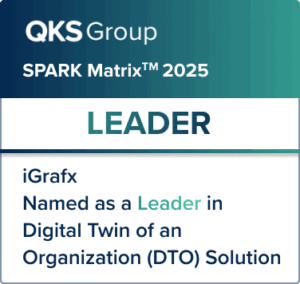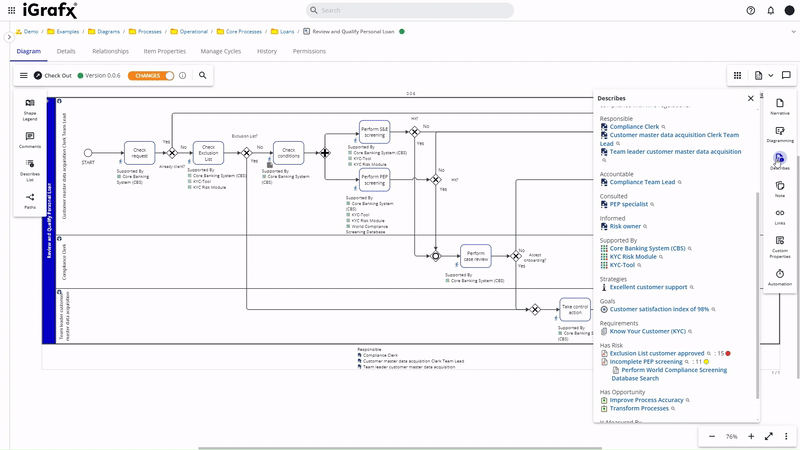Digital transformation with digital twins
Ensure a successful transformation, deliver operational excellence, and improve customer experience by leveraging a digital twin of an organization (DTO) to create a virtual replica of your business operations.
Why Create a DTO?
Hailed as the saving grace of the modern enterprise, digital transformation efforts continue to go over-time, go over-budget, and under-deliver on their initial goals. Organizations today don’t have a solid grip on the true nature of their operations, which levers they can pull to change, or what the knock-on impact of change will be. It’s a process problem.
A DTO provides a solution that ensures your organization realizes actual business value on its digital transformation journey.
It provides a digital model of your business, fed with living data from your systems so that you can understand what’s actually happening, make a plan to improve, and validate your hypotheses before making real investments.
Recognized as an Industry Leader
As an emerging technology, it’s crucial that you can trust your technology partner in building your DTO so that you achieve the business value that you’re after.
For four consecutive years, iGrafx has been named a Leader in the QKS SPARK Matrix for Digital Twin of an Organization.

Benefits
01

Deliver on Digital Transformation
It doesn’t matter if it’s an ERP upgrade, automation, GenAI, or the next silver bullet technology that comes along. These are just building blocks, a DTO gives you the blueprint for your business empire.
02

Make Operational Excellence a Reality
Align every person, every process, every system with your company’s goals and objectives. Orchestrate them to adapt to an ever-changing market landscape. Move from siloed to strongly linked, static to fluid.
03
Give your Customers the Experience they Deserve
Contextualize all of the processes and touchpoints that underpin the journeys that customers embark on when they do business with you. Know which levers you can pull, and what effect those levers have.
The iGrafx Approach
Discover
Discover how your business processes run today to uncover inefficiencies, bottlenecks and opportunities for improvement.
To achieve true digital transformation, you need comprehensive visibility into your as-is processes. iGrafx offers a suite of capabilities that enable this, including process mining, task mining, and process mapping.
Design
Collaboratively design the ideal future versions of your processes and ensure compliance with regulations and internal policies.
Effective transformation requires robust planning and intelligent decision making. iGrafx’s process design solutions, such as our BPM solution and process simulation capability, allow you to model and test proposed improvements without relying on guesswork.
Optimize
Optimize your processes for maximum performance and effective risk management aligned with corporate strategy.
Continuously improve key processes with the help of iGrafx’s predictive analytics and process monitoring solutions.
Capability Highlights
Process Mining
Your DTO is only useful if it mirrors the reality of your business. Process Mining provides real-time data to fuel an accurate, objective, and dynamic view of your operations.


Process Design
Give your organizational data context through digital twins of strategies, people, processes, assets and more in a centralized repository. Define where you want to go and how you’ll get there.
Process Simulation
Validate that your changes are going to have the intended effect by simulating them on your DTO. Don’t risk making investments in production before you know their impact.

Resources
Featured blog
01
Shared services were supposed to be the efficiency silver bullet. Pull all the support functions into one hub, standardize processes, and watch costs drop as efficiency grows. But reality tells a different story entirely. Current research reveals a troubling gap between shared services theory and
You have questions, we have answers
What is the main goal of digital transformation?
From a process intelligence perspective, the main goal of digital transformation is to fundamentally rewire an organization by leveraging digital technologies to optimize and innovate its end-to-end processes. This aims to achieve significant improvements in efficiency, agility, customer experience, and ultimately, create new value and competitive advantage. Process intelligence provides the crucial visibility and data-driven insights to guide these transformations effectively.
What is an example of a digital transformation?
One example of digital transformation would be a traditional bank transitioning from branch-centric operations to a digital-first or omnichannel model. This involves:
- Mobile-first banking apps: Allowing customers to perform most transactions, open accounts, and manage finances entirely from their smartphones.
- AI-powered chatbots/virtual assistants: Providing instant 24/7 customer support and personalized financial advice.
- Automated onboarding and loan processing: Using AI and RPA to reduce paperwork and speed up approvals.
- Data analytics for personalized services: Leveraging customer data to offer tailored products and proactive financial guidance.
This transforms customer experience, operational efficiency, and competitive positioning.
What are the six pillars of digital transformation?
While different frameworks may articulate them slightly differently, the “six pillars” of digital transformation generally encompass a holistic view beyond just technology. Here’s a common interpretation:
- Customer experience: Reimagining and optimizing every customer touchpoint using digital means to create seamless, personalized, and engaging experiences.
- Operations/process: Digitizing and automating core business processes for increased efficiency, agility, and accuracy. This often involves leveraging tools like RPA and process mining.
- Technology: Investing in and integrating the right digital tools, platforms, and infrastructure (e.g., cloud, AI, IoT) to enable the transformation.
- Data & analytics: Leveraging data as a strategic asset to gain insights, inform decision-making, and drive personalized experiences and operational improvements.
- Culture & leadership: Fostering a mindset of innovation, adaptability, and continuous learning throughout the organization, championed by strong leadership.
- People: Equipping employees with the necessary digital skills, fostering collaboration, and adapting organizational structures to support the new digital ways of working.
What is the biggest barrier to digital transformation?
The biggest barrier to digital transformation is often organizational culture and resistance to change. While technology, budget, and skills gaps are significant, if people aren’t willing to adapt, collaborate, and embrace new ways of working, even the most advanced digital tools will fail to deliver their potential. Fear of the unknown, job displacement concerns, and comfort with the status quo can actively derail initiatives.
What are the three main stages of digital transformation?
The three main stages of digital transformation are generally described as:
- Digital enablement: This foundational stage involves converting analog or manual processes and information into digital formats. It’s about getting data online and establishing a technological base.
- Digital optimization: Building on enablement, this stage focuses on using digital tools and integrated systems to enhance existing processes, improve efficiency, and boost productivity. It’s about doing current things better with technology.
- Digital transformation: This is the ultimate stage where digital technologies are leveraged to fundamentally change business models, create new products/services, or explore novel approaches to business, driven by strategic vision rather than just technological improvements.
Talk to a digital transformation expert
Get a custom demo to see what a DTO looks like for your organization.


